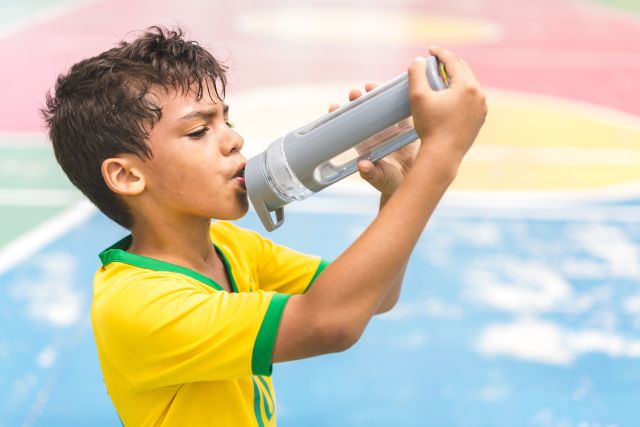Updated on June 14, 2024.
Summer’s here! For many people, that means picnics, road trips, and outdoor adventures. While summer can mean fun in the sun, it’s important to plan ahead and play with caution.
Children are especially vulnerable to the health effects of extreme heat, and many activities can put kids at risk for heat-related illnesses when temperatures rise. Heat-related illnesses (HRIs) are a cluster of conditions that include sunburn, heat stroke, heat exhaustion, cramps, and dehydration.
Fortunately, there are basic steps that any caregiver can follow to help protect children in the heat. Taking a fun, game-based approach can make a big difference in getting kids to listen when it comes to heat safety.
(Note: This article focuses on preventing HRIs in kids. Get more tips on how to recognize and treat heat-related illnesses from the Centers for Disease Control and Prevention.)
Why children are more vulnerable to excessive heat
Children have smaller body mass indexes (BMIs) than adults, says Marilyn Black, PhD, a public health scientist who leads Chemical Insights Research Institute in Marietta, Georgia. As a result, they tend to heat up 3 to 5 times faster. “Not only do their little bodies absorb more heat, but they sweat less and they’re extremely active.”
When children are active, their bodies generate heat, notes Dr. Black. Since children don’t sweat as much—and sweating is the main way the body cools itself down—the heat that gets released from children’s muscles during play largely stays in the body.
“Another thing that’s unique about kids is that they can’t always tell when they’re tired or thirsty,” Black adds. Without the physical reminder to rest and reset, kids’ temperatures may reach dangerous levels with little warning.
Excessive heat risk is not equally shared
Where you live can also play a role in the effects of excessive heat. People who live in cities may experience more severe temperatures during heat waves than those who live in rural and suburban areas. This is due to the ways in which city landscapes—featuring glass, concrete, and asphalt—tend to absorb more heat than natural landscapes.
Research also shows that people of color, and Black people in particular, are more likely to experience extreme heat in the United States. This stems from many factors, including the locations of communities of color and the historic treatment of neighborhoods where people of color tend to live. Namely, histories of segregation and exclusion in systems like housing and health care continue to affect the health and safety of neighborhoods today. These race-based inequities harm people’s health and well-being in many ways.
Heat safety tips: keeping kids safe and cool
Here’s what you can do to keep children safe from excessive heat this season.
Plan activities wisely
Check the temperature before starting any outdoor activity. The sun tends to be strongest between 10 am and 4 pm, so schedule activities for early morning or late afternoon when possible. Set a cut-off temperature for when activities should move inside or be cancelled.
“As a general rule, anything over 90 degrees will introduce real concerns, even if it doesn’t feel especially hot,” says Black. “When temperatures reach 90 degrees, the surfaces children play on, like plastic slides and metal bars, can become hot to touch and can burn the skin.” It also becomes more difficult for the body to regulate its internal temperature when the air temperature rises above 90 degrees.
On hot days, seek out or create play areas with cooling water features and plenty of shade. Think: fountains, hoses, kiddie pools, or misting stands. Before kids use playground equipment, touch the surfaces to make sure they won’t burn. When temperatures soar, consider low- or no-cost indoor activities with air conditioning, like trips to a library, museum, community center, or YMCA.
Help kids stay hydrated
Drinking plenty of fluids can help kids stay cool and avoid HRIs. Children often need reminders to drink because they don’t always feel thirsty. Even when they do, other activities may seem more interesting.
Remember, hydration doesn’t just mean chugging water. Kids and adults need to replace their electrolytes. Electrolytes are minerals like salt and potassium that help your muscles and organs work properly. People lose electrolytes, along with water, when they sweat.
Here are easy tips to make hydration fun:
Pack juicy snacks. Certain foods can be hydrating. Choose snacks that are rich in fluids and electrolytes like watermelon, orange slices, and strawberries.
Encourage creativity. Let kids create their own refreshing beverages by offering a selection of water or seltzer, ice, fresh fruit, and natural juices to mix together.
Make reusable bottles stylish. If time and budgets allow, let kids choose or decorate their own reusable water bottles. Adding their own style can encourage kids to carry and use their bottles with pride.
Important exception: Whenever possible, avoid giving children plastic water bottles (single-use or reusable). These tend to be made from harmful chemicals. Safer materials for kids include 100-percent stainless steel or glass bottles with silicone exteriors.
Spot the signs of dehydration. Teach children that dark or bright yellow urine means they need to drink more. For newly potty-trained kids, this teaching moment could become a simple “pee game” where they are prompted to drink more if their urine is dark. Healthy urine colors like clear or pale yellow can be celebrated.
Avoid sugary drinks. Say “no” to sweetened sodas and fruit drinks when it comes to hydration. These beverages can make dehydration worse due to excessive sugar levels. (High blood sugar levels increase urination, causing you to lose fluids.) Many also contain artificial food dyes or coloring, like chemical reds and blues, that may be harmful to children’s health.
In certain cases, a sports drink or hydration beverage can help replace electrolytes lost through sweating. Check nutrition facts and ingredient labels to find formulations that are low in added sugar and don’t use artificial colors. Kids under two years of age should have 0 grams of added sugar per day. Those over two should have no more than 25 grams.
Pro-tip: Coconut water may be a helpful alternative to sugary, artificially flavored beverages. In fact, it often contains more electrolytes, vitamins, and minerals. (Just be sure to check labels here, too, and avoid brands that add unnecessary salt or sugar.)
Dress for the heat
What your kids wear can make a big difference in how they handle the heat. Choose clothing that helps them stay cool:
Opt for light clothing. Dark colors absorb more heat. Choose whites and pastels if possible. The fabrics you select can also make a difference. “Lightweight, natural materials like cotton ‘breathe’ better,” says Black. These fabrics help the air circulate, which can allow heat to escape and cool air to flow.
Remember hats and sunglasses. A wide-brimmed hat can protect your child’s face and neck from the sun. Sunglasses shield their eyes from the sun’s harmful UV rays.
What to do if kids refuse hats and sunglasses? Offer plain styles for them to decorate and make their own. Markers, stickers, age-appropriate buttons, and items found in nature can turn hats and sunglasses into summer keepsakes. (Just remember to avoid choking hazards for kids under three years of age.)
Choose the right gear for athletes
For young athletes, lightweight, breathable fabrics are key. And while helmets, gear, and padding are essential for many sports from a safety perspective, they can also be an added burden when it comes to heat. Heavy safety equipment can contribute to overheating and make it harder for adults to recognize the signs of HRIs in kids.
“Helmets are often non-porous, meaning there’s nowhere for heat to escape,” says Black. For starters, be sure to look for helmets with air vents built into the structure. Some manufacturers are even developing tiny fans that can be installed inside helmets to help improve airflow.
While these high-tech helmets might take a while to reach youth sports, awareness and basic precautions can go a long way in keeping kids safe from excessive heat. “Regardless of helmet type, it’s important to have rest periods where young athletes remove their helmets to cool down and breathe fresh air,” Black advises. Never skip helmets or safety gear for contact sports—kids need protection, even when it’s hot out.
Help kids love sunscreen
Sunburns can range in severity from painful to life-threatening. Every sunburn increases a child’s lifetime risk of skin cancer, as well. People of all skin tones, including dark skin tones, are at risk for sunburn and skin cancer.
Help kids avoid sunburn by applying sunscreen often, using at least SPF 30. Sunscreen with SPF 30 should be applied 30 minutes before going out and every two hours after that or when sweat or water washes the product away. (When shopping for sunscreen, refer to the Environmental Working Group’s Healthy Living app to identify safe, non-toxic options.)
Kids may try to wriggle away when it’s time to apply SPF. To help kids love sunscreen, consider bringing different-sized paint brushes and let them “paint” it on themselves or one another. (You’ll need to supervise to keep the mess to a minimum and ensure the sunscreen is applied in an even layer.)
If possible, it can help to give kids a choice in sunscreen. If there are options available in your price range with different textures and modes of application (spray versus lotion), let kids pick the one that feels best to them. This can make it feel like their idea to use sunscreen and help you avoid arguments.
Keep indoor spaces cool
Many people don’t have air conditioning (AC) in their homes, says Black, but there are several ways to keep spaces cooler:
- Draw shades during peak sun hours. If the temperature outside is higher than the temperature inside, it’s a good idea to close windows to keep hotter air out and cooler air in.
- Minimize your use of stoves and ovens.
- Run exhaust fans if you have them when cooking or showering to help remove hot air.
Try these strategies, as well:
Use fans wisely. “Fans are extremely important when you don’t have air conditioning,” adds Black. They can be used to blow hot air out of rooms and to pull cooler air in.
You can also get creative with how you use fans: “An age-old trick is to get a box fan for around $20 at your local hardware store,” says Black. “Place a bowl of ice or cold water in front of it to cool the air as it’s blowing.”
Just know that fans alone will not help if you use them to blow hot air at yourself in a room that’s already sweltering (above 90 degrees). This can cause you to become dehydrated faster. If temperatures rise above 90 degrees and you don’t have AC, call your local health department to find a cooling shelter near you.
Consider baths and bedtime fabrics. Cool baths and showers can offer relief. But never submerge a child in cold water since this can send their body into a health crisis called shock.
“Between showers, you can offer kids a cool, water-soaked wrap to put on the back of their neck. At bedtime, dress them in lightweight pajamas,” says Black. “I recommend cotton. For pajamas, sheets, and bedding, this is an excellent, lightweight textile that allows air to move around you.”
Stay safe in cars. If your car lacks AC, avoid driving during peak hours of sun and heat. Remember, keeping car windows closed can be deadly. Never leave a child, pet, or anyone in a parked car, even with the windows cracked. Doing so can quickly lead to heat stroke, organ damage, or death.
Care for yourself, too
Remember to hold yourself to the same safety standards that you set for your kids. It’s easy to become so caught up in caring for little ones that you forget to rest, hydrate, and seek shade yourself.
This may be easier said than done, but one way to remember is to model every reminder you give to kids. Don’t just tell them to hydrate and reapply sunscreen—show them how you do it for yourself. When they’re old enough, you can ask them to give you reminders, too.
This article has been written in collaboration with the Center for Children’s Health Assessment, Research Translation, and Combating Environmental Racism (CHARTER) at Emory University and the Chemical Insights Research Institute (CIRI) of UL Research Institutes, a leading independent safety science organization. CIRI is a nonprofit organization dedicated to researching the ways in which environmental exposures can affect human health and developing strategies for reducing health risks. CIRI provides data and resources to help educators, healthcare providers, and consumers make informed decisions to protect and improve the health of people everywhere.







